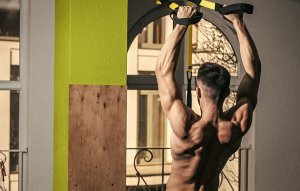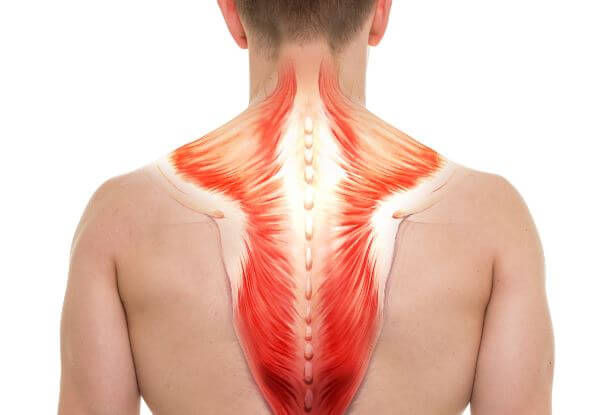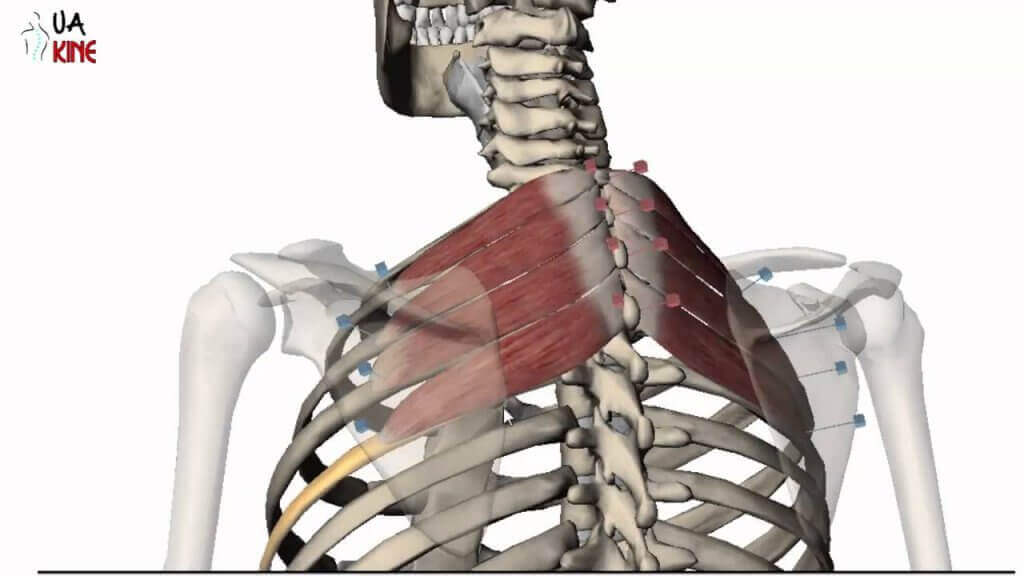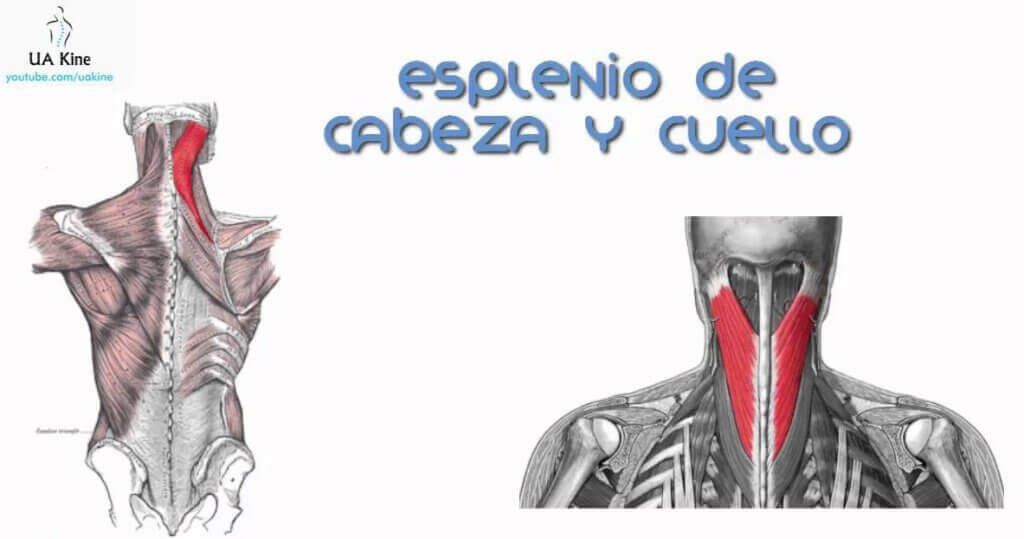Anatomy of the Back Muscles

The area that covers the spine is made up of more than fifteen muscle groups. We don’t need to learn all of the back muscles, but it’s good to have at least one basic notion about them. Find out more about it in the following article.
Superficial back muscles
They associate with the movements of the shoulders and join the clavicles, scapulae and humerus. These are also known as intrinsic back muscles and are covered by deep fascia. They are the following:
1. Trapeze
This muscle is located between the neck and the torso. It owes its name to the geometrical flattened shape with a lower side longer than the upper and two diagonal sides. Covering the neck to the shoulder blades, it’s inserted into the cervical and helps you to move the scapulae, raise your shoulders and turn your head.

2. Dorsal
Out of all the back muscles, the dorsal muscle is the largest, strongest and widest. It’s located on the sides of the trunk, under the shoulder blades and on the ribs. It’s triangular in shape and is essential in several sports such as swimming (butterfly style) and mountain climbing.
3. Scapula
It’s also known as the shoulder blade angle. It’s a triangular muscle, located at the side of the neck and up to the root of the spine of the scapula. The shoulder blades are responsible for moving the scapula and tilting the spine.
4. Rhomboids
The rhomboid muscle is located under the neck, in the center of the back, and goes to the edge of the scapula. It has a trapezoid shape (two horizontal long sides and two vertical short sides). It’s divided into minor and major, according to its location.

Intermediate back muscles
The intermediate back muscles are anchored both in the rib cage and in the spine. Its function is to raise and lower the ribs, as well as to collaborate in the respiratory function. Among them are:
1. Serratus posterior superior
It’s located in the upper part of the back, from the column to the first ribs. It’s born in the posterior cervical ligament and is directed towards the sides of the back.

2. Serratus posterior inferior
It’s located in the lower part of the back, from the spine to the last four ribs. As an action, it plays a very important role along with the wide dorsal to protect the ribs. This muscle is also involved in exhalation.

3. Iliocostalis muscle
It’s divided into lumbar, dorsal and cervical, according to its insertion. It passes through the iliac crest of the coxal, the sacrum, the ribs, the cervical vertebrae and the posterior tubercles of the transverse processes.

Deep back muscles
These muscles must always be worked and trained if you want to achieve good body posture. They extend from the base of the skull to the sacrum, and their main function is to help in the movements of the spine. They are:
1. Splenius muscle
It occupies the nape and the upper part of the back, under the trapezius and the sternocleidomastoid. Its functions are to tilt and rotate the head, as well as extend and hyperextend the skull and neck.

2. Spinal transverse muscles
The spinal transversal or transverse spinous muscle is located in the back of the muscle known as semi-spiny. Its greatest development is located in the lower back.

How to work the back muscles?
Through exercise and stretching, we can strengthen the back muscles. The main benefit of doing so is that it helps us avoid contractures and pain.
There are many routines dedicated entirely to the cervical, dorsal and lumbar areas. However, before doing them, we recommend that you consult with a coach or a physical therapist to know what training routines are best for you.
Your whole back can suffer due to stress, sedentary lifestyles, and poor postures when sleeping or working. Therefore, to avoid stiffness (mainly of the cervical), stretching during the day or before going to sleep is always advisable.
The back muscles require a lot of attention because most of our movements depend on them. Our back muscles support the head and allow us to stay upright. Don’t overlook their training!
The area that covers the spine is made up of more than fifteen muscle groups. We don’t need to learn all of the back muscles, but it’s good to have at least one basic notion about them. Find out more about it in the following article.
Superficial back muscles
They associate with the movements of the shoulders and join the clavicles, scapulae and humerus. These are also known as intrinsic back muscles and are covered by deep fascia. They are the following:
1. Trapeze
This muscle is located between the neck and the torso. It owes its name to the geometrical flattened shape with a lower side longer than the upper and two diagonal sides. Covering the neck to the shoulder blades, it’s inserted into the cervical and helps you to move the scapulae, raise your shoulders and turn your head.

2. Dorsal
Out of all the back muscles, the dorsal muscle is the largest, strongest and widest. It’s located on the sides of the trunk, under the shoulder blades and on the ribs. It’s triangular in shape and is essential in several sports such as swimming (butterfly style) and mountain climbing.
3. Scapula
It’s also known as the shoulder blade angle. It’s a triangular muscle, located at the side of the neck and up to the root of the spine of the scapula. The shoulder blades are responsible for moving the scapula and tilting the spine.
4. Rhomboids
The rhomboid muscle is located under the neck, in the center of the back, and goes to the edge of the scapula. It has a trapezoid shape (two horizontal long sides and two vertical short sides). It’s divided into minor and major, according to its location.

Intermediate back muscles
The intermediate back muscles are anchored both in the rib cage and in the spine. Its function is to raise and lower the ribs, as well as to collaborate in the respiratory function. Among them are:
1. Serratus posterior superior
It’s located in the upper part of the back, from the column to the first ribs. It’s born in the posterior cervical ligament and is directed towards the sides of the back.

2. Serratus posterior inferior
It’s located in the lower part of the back, from the spine to the last four ribs. As an action, it plays a very important role along with the wide dorsal to protect the ribs. This muscle is also involved in exhalation.

3. Iliocostalis muscle
It’s divided into lumbar, dorsal and cervical, according to its insertion. It passes through the iliac crest of the coxal, the sacrum, the ribs, the cervical vertebrae and the posterior tubercles of the transverse processes.

Deep back muscles
These muscles must always be worked and trained if you want to achieve good body posture. They extend from the base of the skull to the sacrum, and their main function is to help in the movements of the spine. They are:
1. Splenius muscle
It occupies the nape and the upper part of the back, under the trapezius and the sternocleidomastoid. Its functions are to tilt and rotate the head, as well as extend and hyperextend the skull and neck.

2. Spinal transverse muscles
The spinal transversal or transverse spinous muscle is located in the back of the muscle known as semi-spiny. Its greatest development is located in the lower back.

How to work the back muscles?
Through exercise and stretching, we can strengthen the back muscles. The main benefit of doing so is that it helps us avoid contractures and pain.
There are many routines dedicated entirely to the cervical, dorsal and lumbar areas. However, before doing them, we recommend that you consult with a coach or a physical therapist to know what training routines are best for you.
Your whole back can suffer due to stress, sedentary lifestyles, and poor postures when sleeping or working. Therefore, to avoid stiffness (mainly of the cervical), stretching during the day or before going to sleep is always advisable.
The back muscles require a lot of attention because most of our movements depend on them. Our back muscles support the head and allow us to stay upright. Don’t overlook their training!
All cited sources were thoroughly reviewed by our team to ensure their quality, reliability, currency, and validity. The bibliography of this article was considered reliable and of academic or scientific accuracy.
- Hansen, L., De Zee, M., Rasmussen, J., Andersen, T. B., Wong, C., & Simonsen, E. B. (2006). Anatomy and biomechanics of the back muscles in the lumbar spine with reference to biomechanical modeling. Spine. https://doi.org/10.1097/01.brs.0000229232.66090.58
This text is provided for informational purposes only and does not replace consultation with a professional. If in doubt, consult your specialist.








